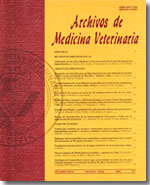Insulin sensitivity before, during and after fasting in ewe lambs
Main Article Content
Abstract
It has been proposed that blood-borne metabolic signals are captured by central or peripheral sensors to inform to the GnRH pulse generator about the metabolic status of the growing animal to make proper adjustments in the GnRH pulsatile secretion. During states of food restriction or fasting, the GnRH, and consequently, the LH secretion are reduced, probably due to inhibitory influences exerted by metabolic signals. Insulin has been suggested as a potential metabolic signal. However, little is known about the insulin sensitivity in prepubertal ewes, during experimental induction of negative energy balance, such as fasting, which may explain in part the effect of insulin as a metabolic signal. The purpose of this study was to establish the insulin sensitivity during fasting in ewe lambs. Six ewe lambs were given a bolus of insulin (0.1 IU/kg BW), one day before (day 0), on day 1, on day 8 of fasting and 24 hours (day 9) after the end of the 8-days fast. Plasma glucose concentrations were measured at 0,3,5,7,10, and 15 min after the insulin administrations to calculate the insulin sensitivity index (ISI= glucose at time 0 (G0) minus glucose at time 15, obtained from a regression curve, divided by G0). Plasma insulin concentrations were measured at-5, 0,3,5,7,10,15,20, and 60 min after insulin administration. On the other hand, plasma LH concentrations were measured at 0,10,20,40 and 60 min after insulin administrations in each day of the study to determine the effect of insulin on the acute LH secretion. Basal plasma concentrations of cortisol on day 0, day 1, 8 and 9 were also determined. The ISI did not change from day 0 to day 1, but decreased from day 1 to day 8 of fasting, range: 0.21 to 0.28 and -0.36 to 0.22 respectively with a median of 0.23 and 0.02 respectively (P<0.05). The ISI values on day 9 were not recovered; range: 0.02 to 0.28, with a median of 0.09. Plasma glucose concentrations descended linearly after insulin on day 0 and on day 1 of fasting, but not in day 8 and 9. Plasma insulin concentrations increased abruptly, reaching a peak at 3 min, and descending slowly thereafter in each day of the study. Plasma LH concentrations did not change with the insulin administrations. Fasting reduced basal plasma levels of glucose and LH and tended to reduce plasma insulin concentrations (P<0.08). Cortisol concentrations did not change during fasting. Results suggest that the insulin sensitivity is reduced with fasting in ewe lambs. A 24 hr refeeding is not sufficient to recover the insulin sensitivity, neither the LH basal plasma concentrations. This reduction in insulin sensitivity may allow other homeostatic mechanisms to operate to maintain plasma glucose levels. The insulin challenge did not affect plasma LH concentrations. Absence of changes in basal plasma cortisol concentrations suggests that fasting did not activate the adrenal axis.

